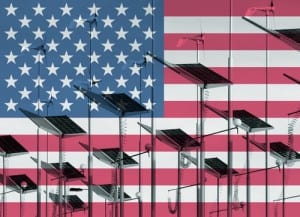Since the beginning, President Donald Trump promised that stripping regulations on oil companies would drive employment. “We’re bringing back jobs big league,” he said.

But, after six months of regulatory rollback, Trump has done almost nothing that will create jobs on oil fields or offshore rigs. That’s because low oil prices, not environmental protections, are stunting job growth, and Trump’s push to nix federal regulations and expand drilling will only make oil cheaper.
Foreign producers have flooded the market, driving down the price of crude oil. Oil giants like Exxon have seen earnings drop off as a result.
In an effort to cut costs and salvage profits, oil companies are laying off workers or automating operations, replacing workers with machines. Drilling rigs have gotten more efficient, allowing companies to pump the same volume of oil with half as much equipment and far fewer workers.
Automation is creating a small number of high-tech jobs for skilled workers, but it’s eliminating the well-paid blue collar jobs Trump promised to deliver.

The oil and gas extraction sector lost more than 140,000 jobs between 2014 and 2016, when the price of oil hit a slump. The industry lost three times as many jobs over that period than it did between 2008 and 2009, during the recession.

“When the inputs to a business get cheaper, that causes the business to expand, increasing employment,” said Mark Jacobsen, professor of economics at UC San Diego. “From the perspective of a U.S. oil producer, input costs haven’t changed much, but the output they produce is [now] worth very little. This causes the business to shrink, decreasing employment.”
Even if the price of oil rebounds, it likely won’t do so permanently. Electric vehicles are getting cheaper every day, and sales numbers for EVs are growing by leaps and bounds.
Over the next few years, this will likely stunt demand for gas, leading to an oversupply of oil and a further downturn in prices, according to analysis from Bloomberg.
The situation isn’t likely to change. The United Kingdom, France and Norway have all passed laws banning the sale of gas-powered cars by 2040 or, in the case of Norway, 2025. Other countries are likely to follow suit.
Technology and economics, not environmental protections, are driving the loss of jobs. There is very little that this president — or any president — can do about it.
Those environmental protections, however, are key to warding off the punishing heat waves, powerful storms and persistent drought associated with climate change. Trump, for example, has tried axing a rule that limits methane pollution from oil and gas drilling sites.
The measure, which imposes marginal costs on energy firms, is vital to reining in emissions of this extremely potent greenhouse gas. A recent draft report from 13 federal agencies was leaked to the press.
It shows that a high-emissions scenario will result in as much as 10 degrees F of warming in the United States and up to 8 feet of sea level rise.
But Trump has turned a blind eye to carbon crisis. His energy policies fall into two broad categories. There are those that ease restrictions on oil companies — like his decision to allow firms to lobby foreign governments in secret. Then, there are his efforts to open up federal lands and waters to drilling.
Trump’s proposed budget calls for opening the Arctic National Wildlife Refuge to drilling. He has already signed executive orders calling for federal agencies to lift restrictions on offshore drilling, approve the construction of the Dakota Access and Keystone XL pipelines, and review monument designations with an eye to opening federal lands to oil drilling.
“By increasing the amount of government land available for drilling, this could reduce the price producers pay for the land,” said Jacobsen. “However, the difficulty in the case of oil is that increases in supply will just continue to drive down the price of the product, making it a difficult proposition to help the sector.”
In other words, making it easier and cheaper to drill oil will do nothing to increase prices and create jobs. While Trump appears to understand that more production will suppress prices, he fails to see that lower prices will hurt job prospects.

Trump took credit for Exxon’s plans to revamp its Gulf Coast refining facilities and create 45,000 new jobs, but his policies had nothing to do with the effort.
Exxon began work on the project in 2013. Trump’s said that lifting restrictions on oil and gas development will create half a million jobs, but that claim comes from a widely discredited report from the Koch-backed Institute for Energy Research.
As it is, the price of oil is simply too low to justify expanding production. The controversial Keystone XL pipeline offers a case in point. In the years since opponents first took up arms against the project, the price of oil has plummeted.
Now, companies are backing away from the Canadian tar sands, which are difficult and costly to drill. Despite having the backing of the Trump administration, the project may ultimately go nowhere.
Is there anything the president can do to create oil jobs? Trump has calledfor a rollback of fuel standards for cars and trucks. The move could buoy demand for oil in the short term, but it will do nothing to stop the long-term shift to electric vehicles.
All of this throws a wrench into Trump’s $1 trillion infrastructure plan, which he promised would be paid for by the tax revenue from fossil fuel production.
As Inside Climate News reported, to raise that much revenue, the federal government would have to dramatically raise taxes on oil or oil prices would have to skyrocket. Neither is likely to happen under the current administration.
Trump wouldn’t want to drive up the price of oil. Cheap gas is good for consumer spending. When people spend less on fuel, they have more money leftover to put toward other purchases.
Moreover, an analysis from the University of Virginia shows a link between the cost of gas and support for presidents. High gas prices would likely hurt Trump’s already abysmal approval ratings.
If the president wants invigorate the energy sector, he might look to renewables. Solar jobs are growing 17 times faster than the economy as a whole, while wind technician is the fastest-growing job in the country.
These are blue-collar jobs that don’t require a college degree and can’t be automated or outsourced. Trump could use his office to spur the growth of these fields.
“Continued investment in research and development could bring down the costs of clean-energy inputs even further, continuing to help the sector,” Jacobsen said. “Government commitment to improve air quality can also help the clean-energy sector, since it makes the costs faced by their competition higher.”
It may sound paradoxical that low oil prices would stunt job growth in the oil sector, while low prices for wind and solar would create jobs in the clean-energy sector.
That’s because oil prices are being suppressed by glut of supply, which forces companies to lay off workers to remain profitable. The cost of renewables is falling thanks to technological advances, making the product more attractive to consumers.
“If oil prices are low, the oil industry has to curb its activities. That translates into job losses,” said Karl Cates, a spokesperson for the Institute for Energy Economics and Financial Analysis.
“Low prices for solar and wind are good for employment in the clean-energy sector because they drive deployment. Renewables represent an emerging sector that has huge cost advantages.
It’s growing because it’s cheaper. Growth, of course, means more jobs.”
Trump likely won’t change course on energy policy. Too bad. He has the opportunity to create jobs “big league.”
Jeremy Deaton writes for Nexus Media, a syndicated newswire covering climate, energy, policy, art and culture. You can follow him @deaton_jeremy.
Source: NexusMedia. Reproduced with permission.










